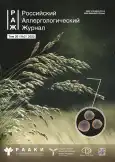Маски аллергического ринита: назальный полипоз у двух детей дошкольного возраста
- Авторы: Мачарадзе Д.Ш.1, Попадюк В.И.1
-
Учреждения:
- Российский университет дружбы народов имени Патриса Лумумбы
- Выпуск: Том 20, № 2 (2023)
- Страницы: 250-258
- Раздел: Описания клинических случаев
- URL: https://journals.rcsi.science/raj/article/view/253527
- DOI: https://doi.org/10.36691/RJA1595
- ID: 253527
Цитировать
Полный текст
Аннотация
У детей особенно часто встречаются такие назальные симптомы, как заложенность носа, ринорея и кашель. Несмотря на симптоматическое лечение (назальные спреи, физиотерапия, приём антибиотиков и топических глюкокортикостероидов), заложенность носа может сохраняться длительно. В подобных случаях наиболее предполагаемыми являются несколько заболеваний: аденоиды, аллергический ринит, различные аномалии строения внутриносовых структур и пазух (например, искривление перегородки носа), риносинусит (острый, подострый). При наличии у ребёнка двух основных ― заложенности и отделяемого из носа ― и таких дополнительных симптомов, как головная боль с преимущественной локализацией в области околоносовых пазух и ухудшение обоняния (возможно также вкуса пищи), на протяжении более 3 месяцев необходимо исключить диагноз хронического риносинусита, который может сочетаться с назальным полипом.
Цель данной статьи ― проанализировать клинические случаи хронического риносинусита с назальным полипом у двух детей дошкольного возраста, в том числе с непереносимостью нестероидных противовоспалительных препаратов у одного из них, и повысить осведомлённость врачей по данной нозологии.
У детей с такими симптомами, как длительная заложенность носа, ринорея, нарушение обоняния, головная боль, непереносимость нестероидных противовоспалительных препаратов, при отсутствии сенсибилизации и иммунодефицита рекомендовано назначение компьютерной томографии околоносовых пазух с целью исключения назального полипа.
Полный текст
Открыть статью на сайте журналаОб авторах
Дали Шотаевна Мачарадзе
Российский университет дружбы народов имени Патриса Лумумбы
Автор, ответственный за переписку.
Email: dalim_a@mail.ru
ORCID iD: 0000-0001-5999-7085
SPIN-код: 2399-5783
д-р мед. наук, профессор
Россия, 117198, Москва, ул. Миклухо-Маклая, д. 6Валентин Иванович Попадюк
Российский университет дружбы народов имени Патриса Лумумбы
Email: popadyuk-vi@rudn.ru
ORCID iD: 0000-0003-3309-4683
SPIN-код: 6284-8040
д.м.н., профессор, декан
Россия, 117198, Москва, ул. Миклухо-Маклая, д. 6Список литературы
- Villwock J., Kuppersmith R. Diagnostic algorithm for evaluating nasal airway obstruction // Otolaryngol Clin N Am. 2018. Vol. 51, N 5. P. 867–872. doi: 10.1016/j.otc.2018.05.002
- Brietzke S., Shin J., Choi S., et al. Clinical consensus statement: Pediatric chronic rhinosinusitis // Otolaryngol Head Neck Surg. 2014. Vol. 151, N 4. P. 542–553. doi: 10.1177/0194599814549302
- Poachanukoon O., Nanthapisal S., Chaumrattanakul U. Pediatric acute and chronic rhinosinusitis: Comparison of clinical characteristics and outcome of treatment // Asian Pac J Allergy Immunol. 2012. Vol. 30, N 2. P. 146–151.
- Leo G., Triulzi F., Incorvaia C. Diagnosis of chronic rhinosinusitis // Pediatr Allergy Immunol. 2012. Vol. 23, Suppl. 22. P. 20–26. doi: 10.1111/j.1399-3038.2012.01320
- Magit A. Pediatric rhinosinusitis // Otolaryngol Clin N Am. 2014. Vol. 47, N 5. P. 733–746. doi: 10.1016/j.otc.2014.06.003
- Fokkens W., Lund V., Hopkins C., et al. European position paper on rhinosinusitis and nasal polyps 2020 // Rhinology. 2020. Vol. 58, Suppl. S29. P. 1–464. doi: 10.4193/Rhin20.401
- Heath J., Hartzell L., Putt C., Kennedy J. Chronic rhinosinusitis in children: Pathophysiology, evaluation, and medical management // Curr Allergy Asthma Rep. 2018. Vol. 18, N 7. P. 37. doi: 10.1007/s11882-018-0792-8
- Akdis C., Bachert C., Cingi C., et al. Endotypes and phenotypes of chronic rhinosinusitis: A PRACTALL document of the European Academy of Allergy and Clinical Immunology and the American Academy of Allergy, Asthma & Immunology // J Allergy Clin Immunol. 2013. Vol. 131, N 6. P. 1479–1490. doi: 10.1016/j.jaci.2013.02.036
- Chandra R., Lin D., Tan B., et al. Chronic rhinosinusitis in the setting of other chronic inflammatory diseases // Am J Otolaryngol. 2011. Vol. 32, N 5. P. 388–391. doi: 10.1016/j.amjoto.2010.07.013
- McCormick J., Thompson H., Cho D., et al. Phenotypes in chronic rhinosinusitis // Curr Allergy Asthma Rep. 2020. Vol. 20, N 7. P. 20. doi: 10.1007/s11882-020-00916-6
- Poddighe D., Brambilla I., Licari A., Marseglia G. Pediatric rhinosinusitis and asthma // Respir Med. 2018. N 141. P. 94–99. doi: 10.1016/j.rmed.2018.06.016
- Karakaya G., Celebioglu E., Kalyoncu A.F. Non-steroidal anti-inflammatory drug hypersensitivity in adults and the factors associated with asthma // Respir Med. 2013. Vol. 107, N 7. P. 967–974. doi: 10.1016/j.rmed.2013.03.014
- Di Cicco M., Bizzoco F., Morelli E., et al. Nasal polyps in children: The early origins of a challenging adulthood condition // Children (Basel). 2021. Vol. 8, N 11. P. 997. doi: 10.3390/children8110997
- Kowalski M., Agache I., Bavbek S., et al. Diagnosis and management of NSAID-exacerbated respiratory disease (N-ERD): A EAACI position paper // Allergy. 2019. Vol. 74, N 1. P. 28–39. doi: 10.1111/all.13599
- Varghese M., Lockey R. Aspirin-execerbated asthma // Allergy Asthma Clin Immunol. 2008. Vol. 4, N 2. P. 75–83. doi: 10.1186/1710-1492-4-2-75
- McGarry G., Melia L. Nasal polyps: An update // Br J Hosp Med (Lond). 2009. Vol. 70, N 9. P. 500–504. doi: 10.12968/hmed.2009.70.9.43865
- Dávila I., Rondón C., Navarro А., et al. Aeroallergen sensitization influences quality of life and comorbidities in patients with nasal polyposis // Am J Rhinol Allergy. 2012. Vol. 26, N 5. P. 126–131. doi: 10.2500/ajra.2012.26.3792
- De Cock J., Zanca F., Canning J., et al. A comparative study for image quality and radiation dose of a cone beam computed tomography scanner and a multislice computed tomography scanner for paranasal sinus imaging // Eur Radiol. 2015. Vol. 25, N 7. P. 1891–1900. doi: 10.1007/s00330-015-3593-7
- Lawrence M., Palacios-Kibler T., Workman L., et al. Low serum IgE is a sensitive and specific marker for common variable immunodeficiency (CVID) // J Clin Immunol. 2018. Vol. 38, N 3. P. 225–233. doi: 10.1007/s10875- 018-0476-0
- Niu X., Wu Z., Xiao X., et al. The relationship between adenoid hypertrophy and gastroesophageal reflux disease: A meta-analysis // Medicine (Baltimore). 2018. Vol. 97, N 41. P. e12540. doi: 10.1097/MD.0000000000012540
- Мачарадзе Д.Ш., Сидоренко И.В. Распространенность непереносимости аспирина и аспириновой астмы у детей с бронхиальной астмой // Аллергия, астма и клиническая иммунология. 2002. № 6. С. 3.
Дополнительные файлы






